Prime Ministerial Instability in Australia: Factors & Policy Impact
VerifiedAdded on 2023/04/11
|9
|2256
|460
Essay
AI Summary
This essay examines the issue of rapid changes in Australian Prime Ministers over the past decade, exploring the underlying factors and their impact on contemporary Australian politics and public policy. It argues that frequent leadership transitions, driven by factors such as internal party dynamics and constitutional provisions, have led to political instability and inconsistent policy-making. The essay analyzes how changes in Prime Ministers influence political ideologies, economic reforms, and party structures. It also discusses the negative impact of this instability on Australia's domestic and international reputation. The conclusion emphasizes that addressing the internal mechanisms and ideological differences within political parties is crucial to mitigating the issue of frequent leadership changes and their detrimental effects on the Australian political landscape. Desklib offers a range of resources, including past papers and solved assignments, to aid students in their academic pursuits.
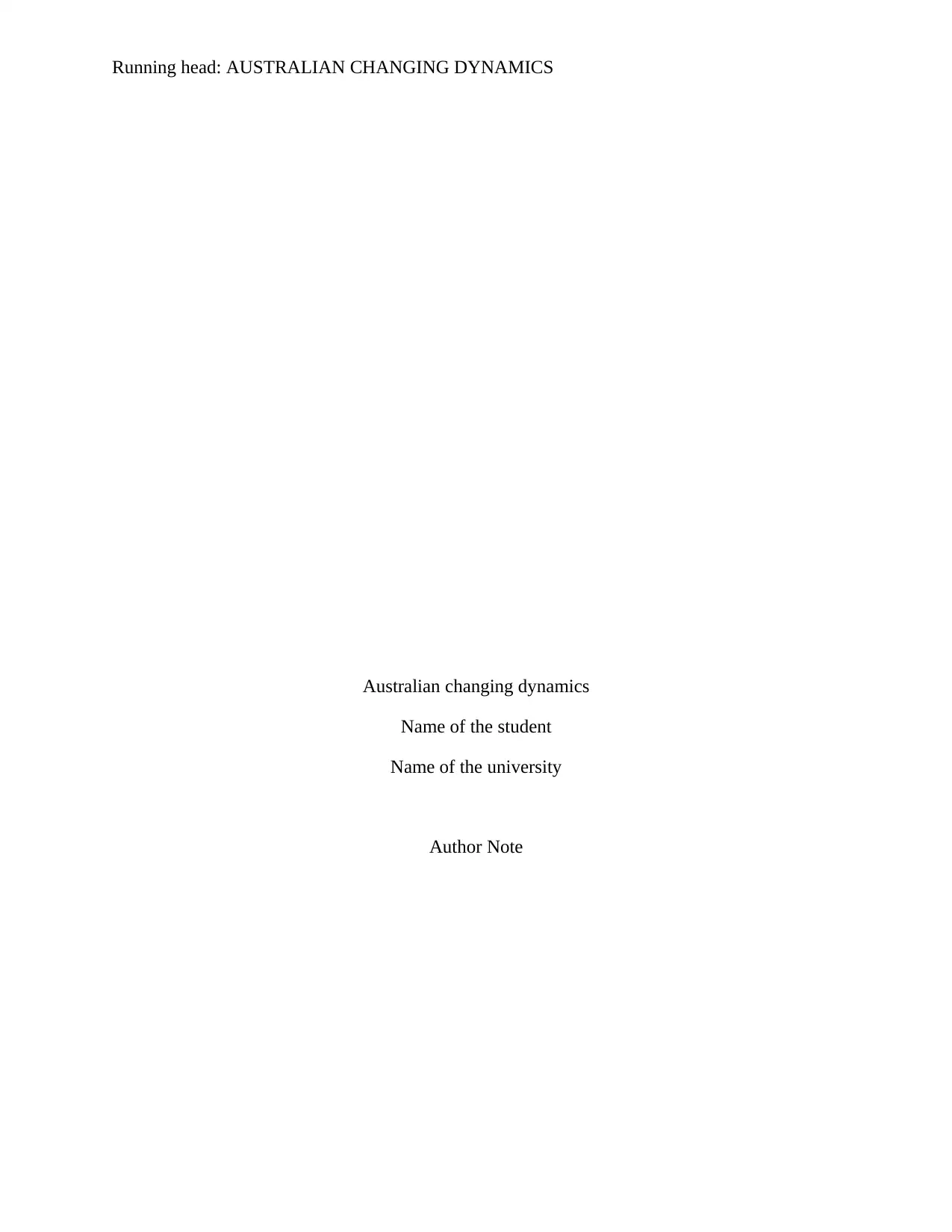
Running head: AUSTRALIAN CHANGING DYNAMICS
Australian changing dynamics
Name of the student
Name of the university
Author Note
Australian changing dynamics
Name of the student
Name of the university
Author Note
Paraphrase This Document
Need a fresh take? Get an instant paraphrase of this document with our AI Paraphraser
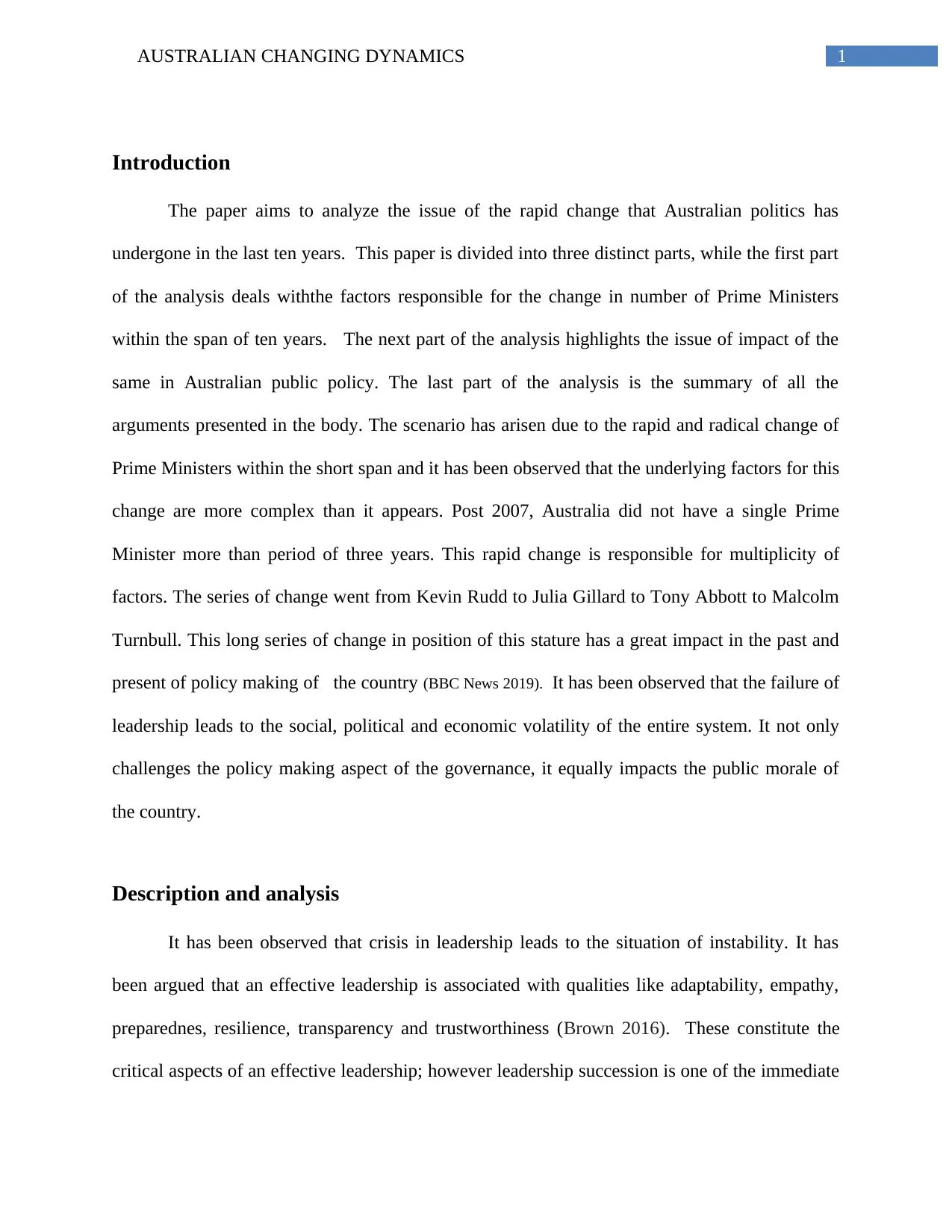
1AUSTRALIAN CHANGING DYNAMICS
Introduction
The paper aims to analyze the issue of the rapid change that Australian politics has
undergone in the last ten years. This paper is divided into three distinct parts, while the first part
of the analysis deals withthe factors responsible for the change in number of Prime Ministers
within the span of ten years. The next part of the analysis highlights the issue of impact of the
same in Australian public policy. The last part of the analysis is the summary of all the
arguments presented in the body. The scenario has arisen due to the rapid and radical change of
Prime Ministers within the short span and it has been observed that the underlying factors for this
change are more complex than it appears. Post 2007, Australia did not have a single Prime
Minister more than period of three years. This rapid change is responsible for multiplicity of
factors. The series of change went from Kevin Rudd to Julia Gillard to Tony Abbott to Malcolm
Turnbull. This long series of change in position of this stature has a great impact in the past and
present of policy making of the country (BBC News 2019). It has been observed that the failure of
leadership leads to the social, political and economic volatility of the entire system. It not only
challenges the policy making aspect of the governance, it equally impacts the public morale of
the country.
Description and analysis
It has been observed that crisis in leadership leads to the situation of instability. It has
been argued that an effective leadership is associated with qualities like adaptability, empathy,
preparednes, resilience, transparency and trustworthiness (Brown 2016). These constitute the
critical aspects of an effective leadership; however leadership succession is one of the immediate
Introduction
The paper aims to analyze the issue of the rapid change that Australian politics has
undergone in the last ten years. This paper is divided into three distinct parts, while the first part
of the analysis deals withthe factors responsible for the change in number of Prime Ministers
within the span of ten years. The next part of the analysis highlights the issue of impact of the
same in Australian public policy. The last part of the analysis is the summary of all the
arguments presented in the body. The scenario has arisen due to the rapid and radical change of
Prime Ministers within the short span and it has been observed that the underlying factors for this
change are more complex than it appears. Post 2007, Australia did not have a single Prime
Minister more than period of three years. This rapid change is responsible for multiplicity of
factors. The series of change went from Kevin Rudd to Julia Gillard to Tony Abbott to Malcolm
Turnbull. This long series of change in position of this stature has a great impact in the past and
present of policy making of the country (BBC News 2019). It has been observed that the failure of
leadership leads to the social, political and economic volatility of the entire system. It not only
challenges the policy making aspect of the governance, it equally impacts the public morale of
the country.
Description and analysis
It has been observed that crisis in leadership leads to the situation of instability. It has
been argued that an effective leadership is associated with qualities like adaptability, empathy,
preparednes, resilience, transparency and trustworthiness (Brown 2016). These constitute the
critical aspects of an effective leadership; however leadership succession is one of the immediate
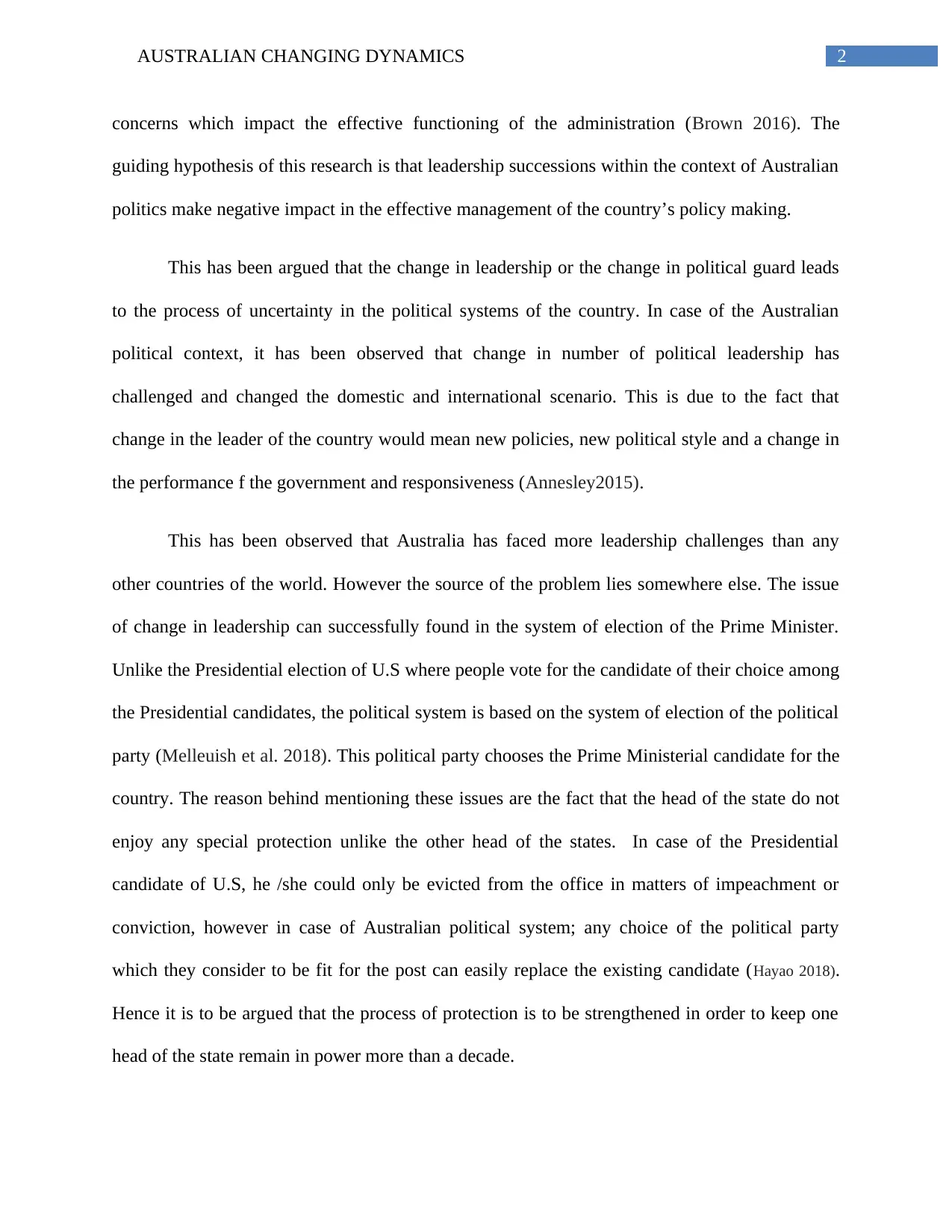
2AUSTRALIAN CHANGING DYNAMICS
concerns which impact the effective functioning of the administration (Brown 2016). The
guiding hypothesis of this research is that leadership successions within the context of Australian
politics make negative impact in the effective management of the country’s policy making.
This has been argued that the change in leadership or the change in political guard leads
to the process of uncertainty in the political systems of the country. In case of the Australian
political context, it has been observed that change in number of political leadership has
challenged and changed the domestic and international scenario. This is due to the fact that
change in the leader of the country would mean new policies, new political style and a change in
the performance f the government and responsiveness (Annesley2015).
This has been observed that Australia has faced more leadership challenges than any
other countries of the world. However the source of the problem lies somewhere else. The issue
of change in leadership can successfully found in the system of election of the Prime Minister.
Unlike the Presidential election of U.S where people vote for the candidate of their choice among
the Presidential candidates, the political system is based on the system of election of the political
party (Melleuish et al. 2018). This political party chooses the Prime Ministerial candidate for the
country. The reason behind mentioning these issues are the fact that the head of the state do not
enjoy any special protection unlike the other head of the states. In case of the Presidential
candidate of U.S, he /she could only be evicted from the office in matters of impeachment or
conviction, however in case of Australian political system; any choice of the political party
which they consider to be fit for the post can easily replace the existing candidate (Hayao 2018).
Hence it is to be argued that the process of protection is to be strengthened in order to keep one
head of the state remain in power more than a decade.
concerns which impact the effective functioning of the administration (Brown 2016). The
guiding hypothesis of this research is that leadership successions within the context of Australian
politics make negative impact in the effective management of the country’s policy making.
This has been argued that the change in leadership or the change in political guard leads
to the process of uncertainty in the political systems of the country. In case of the Australian
political context, it has been observed that change in number of political leadership has
challenged and changed the domestic and international scenario. This is due to the fact that
change in the leader of the country would mean new policies, new political style and a change in
the performance f the government and responsiveness (Annesley2015).
This has been observed that Australia has faced more leadership challenges than any
other countries of the world. However the source of the problem lies somewhere else. The issue
of change in leadership can successfully found in the system of election of the Prime Minister.
Unlike the Presidential election of U.S where people vote for the candidate of their choice among
the Presidential candidates, the political system is based on the system of election of the political
party (Melleuish et al. 2018). This political party chooses the Prime Ministerial candidate for the
country. The reason behind mentioning these issues are the fact that the head of the state do not
enjoy any special protection unlike the other head of the states. In case of the Presidential
candidate of U.S, he /she could only be evicted from the office in matters of impeachment or
conviction, however in case of Australian political system; any choice of the political party
which they consider to be fit for the post can easily replace the existing candidate (Hayao 2018).
Hence it is to be argued that the process of protection is to be strengthened in order to keep one
head of the state remain in power more than a decade.
⊘ This is a preview!⊘
Do you want full access?
Subscribe today to unlock all pages.

Trusted by 1+ million students worldwide
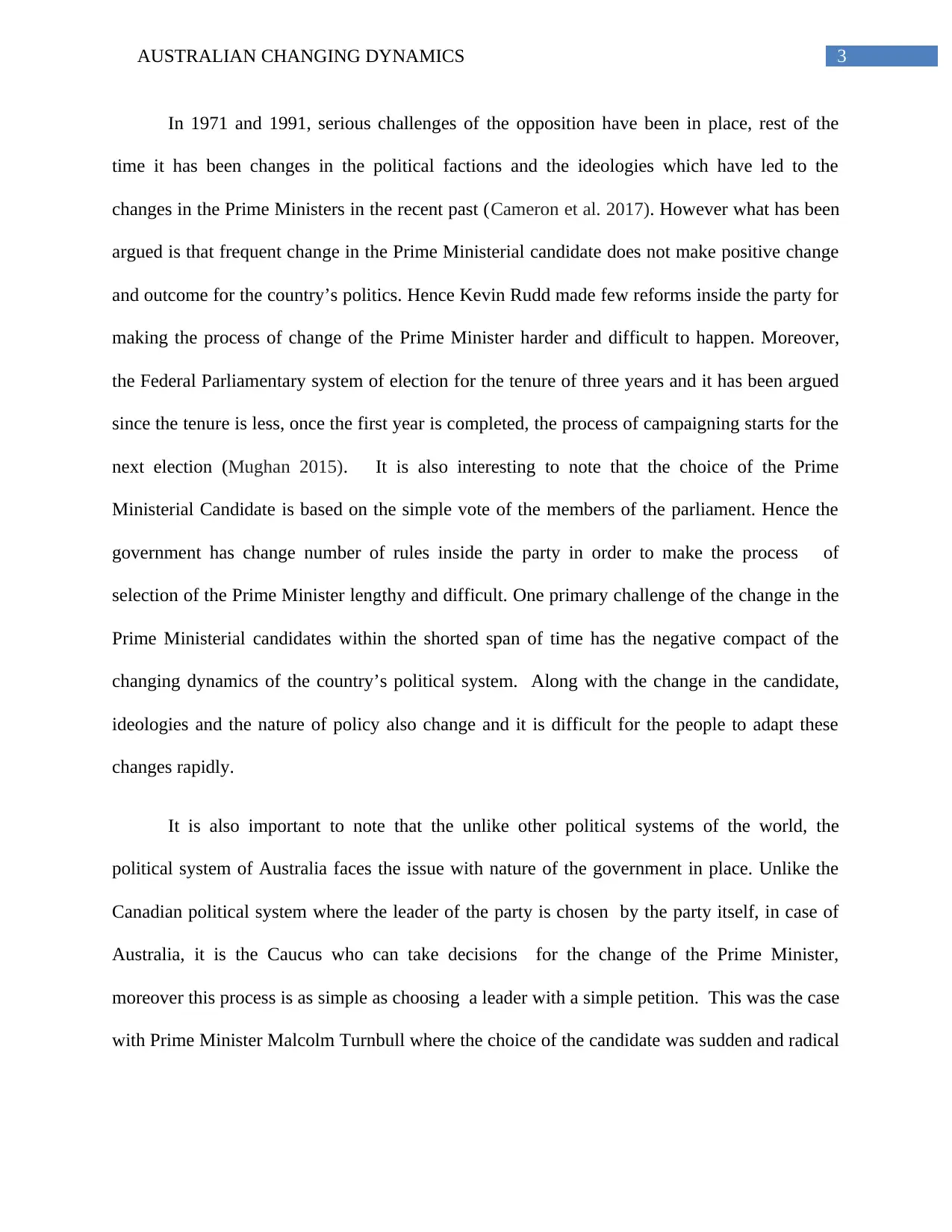
3AUSTRALIAN CHANGING DYNAMICS
In 1971 and 1991, serious challenges of the opposition have been in place, rest of the
time it has been changes in the political factions and the ideologies which have led to the
changes in the Prime Ministers in the recent past (Cameron et al. 2017). However what has been
argued is that frequent change in the Prime Ministerial candidate does not make positive change
and outcome for the country’s politics. Hence Kevin Rudd made few reforms inside the party for
making the process of change of the Prime Minister harder and difficult to happen. Moreover,
the Federal Parliamentary system of election for the tenure of three years and it has been argued
since the tenure is less, once the first year is completed, the process of campaigning starts for the
next election (Mughan 2015). It is also interesting to note that the choice of the Prime
Ministerial Candidate is based on the simple vote of the members of the parliament. Hence the
government has change number of rules inside the party in order to make the process of
selection of the Prime Minister lengthy and difficult. One primary challenge of the change in the
Prime Ministerial candidates within the shorted span of time has the negative compact of the
changing dynamics of the country’s political system. Along with the change in the candidate,
ideologies and the nature of policy also change and it is difficult for the people to adapt these
changes rapidly.
It is also important to note that the unlike other political systems of the world, the
political system of Australia faces the issue with nature of the government in place. Unlike the
Canadian political system where the leader of the party is chosen by the party itself, in case of
Australia, it is the Caucus who can take decisions for the change of the Prime Minister,
moreover this process is as simple as choosing a leader with a simple petition. This was the case
with Prime Minister Malcolm Turnbull where the choice of the candidate was sudden and radical
In 1971 and 1991, serious challenges of the opposition have been in place, rest of the
time it has been changes in the political factions and the ideologies which have led to the
changes in the Prime Ministers in the recent past (Cameron et al. 2017). However what has been
argued is that frequent change in the Prime Ministerial candidate does not make positive change
and outcome for the country’s politics. Hence Kevin Rudd made few reforms inside the party for
making the process of change of the Prime Minister harder and difficult to happen. Moreover,
the Federal Parliamentary system of election for the tenure of three years and it has been argued
since the tenure is less, once the first year is completed, the process of campaigning starts for the
next election (Mughan 2015). It is also interesting to note that the choice of the Prime
Ministerial Candidate is based on the simple vote of the members of the parliament. Hence the
government has change number of rules inside the party in order to make the process of
selection of the Prime Minister lengthy and difficult. One primary challenge of the change in the
Prime Ministerial candidates within the shorted span of time has the negative compact of the
changing dynamics of the country’s political system. Along with the change in the candidate,
ideologies and the nature of policy also change and it is difficult for the people to adapt these
changes rapidly.
It is also important to note that the unlike other political systems of the world, the
political system of Australia faces the issue with nature of the government in place. Unlike the
Canadian political system where the leader of the party is chosen by the party itself, in case of
Australia, it is the Caucus who can take decisions for the change of the Prime Minister,
moreover this process is as simple as choosing a leader with a simple petition. This was the case
with Prime Minister Malcolm Turnbull where the choice of the candidate was sudden and radical
Paraphrase This Document
Need a fresh take? Get an instant paraphrase of this document with our AI Paraphraser
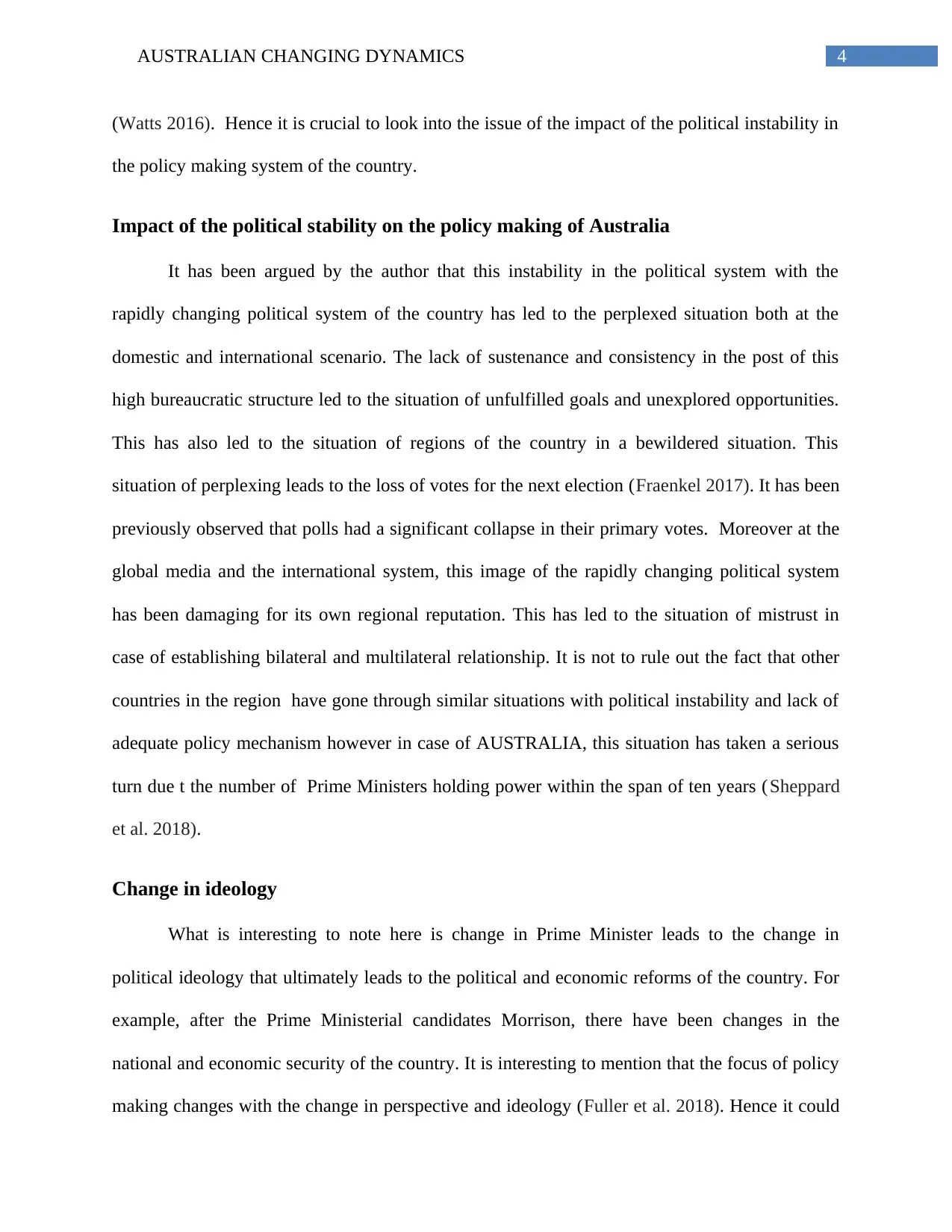
4AUSTRALIAN CHANGING DYNAMICS
(Watts 2016). Hence it is crucial to look into the issue of the impact of the political instability in
the policy making system of the country.
Impact of the political stability on the policy making of Australia
It has been argued by the author that this instability in the political system with the
rapidly changing political system of the country has led to the perplexed situation both at the
domestic and international scenario. The lack of sustenance and consistency in the post of this
high bureaucratic structure led to the situation of unfulfilled goals and unexplored opportunities.
This has also led to the situation of regions of the country in a bewildered situation. This
situation of perplexing leads to the loss of votes for the next election (Fraenkel 2017). It has been
previously observed that polls had a significant collapse in their primary votes. Moreover at the
global media and the international system, this image of the rapidly changing political system
has been damaging for its own regional reputation. This has led to the situation of mistrust in
case of establishing bilateral and multilateral relationship. It is not to rule out the fact that other
countries in the region have gone through similar situations with political instability and lack of
adequate policy mechanism however in case of AUSTRALIA, this situation has taken a serious
turn due t the number of Prime Ministers holding power within the span of ten years (Sheppard
et al. 2018).
Change in ideology
What is interesting to note here is change in Prime Minister leads to the change in
political ideology that ultimately leads to the political and economic reforms of the country. For
example, after the Prime Ministerial candidates Morrison, there have been changes in the
national and economic security of the country. It is interesting to mention that the focus of policy
making changes with the change in perspective and ideology (Fuller et al. 2018). Hence it could
(Watts 2016). Hence it is crucial to look into the issue of the impact of the political instability in
the policy making system of the country.
Impact of the political stability on the policy making of Australia
It has been argued by the author that this instability in the political system with the
rapidly changing political system of the country has led to the perplexed situation both at the
domestic and international scenario. The lack of sustenance and consistency in the post of this
high bureaucratic structure led to the situation of unfulfilled goals and unexplored opportunities.
This has also led to the situation of regions of the country in a bewildered situation. This
situation of perplexing leads to the loss of votes for the next election (Fraenkel 2017). It has been
previously observed that polls had a significant collapse in their primary votes. Moreover at the
global media and the international system, this image of the rapidly changing political system
has been damaging for its own regional reputation. This has led to the situation of mistrust in
case of establishing bilateral and multilateral relationship. It is not to rule out the fact that other
countries in the region have gone through similar situations with political instability and lack of
adequate policy mechanism however in case of AUSTRALIA, this situation has taken a serious
turn due t the number of Prime Ministers holding power within the span of ten years (Sheppard
et al. 2018).
Change in ideology
What is interesting to note here is change in Prime Minister leads to the change in
political ideology that ultimately leads to the political and economic reforms of the country. For
example, after the Prime Ministerial candidates Morrison, there have been changes in the
national and economic security of the country. It is interesting to mention that the focus of policy
making changes with the change in perspective and ideology (Fuller et al. 2018). Hence it could
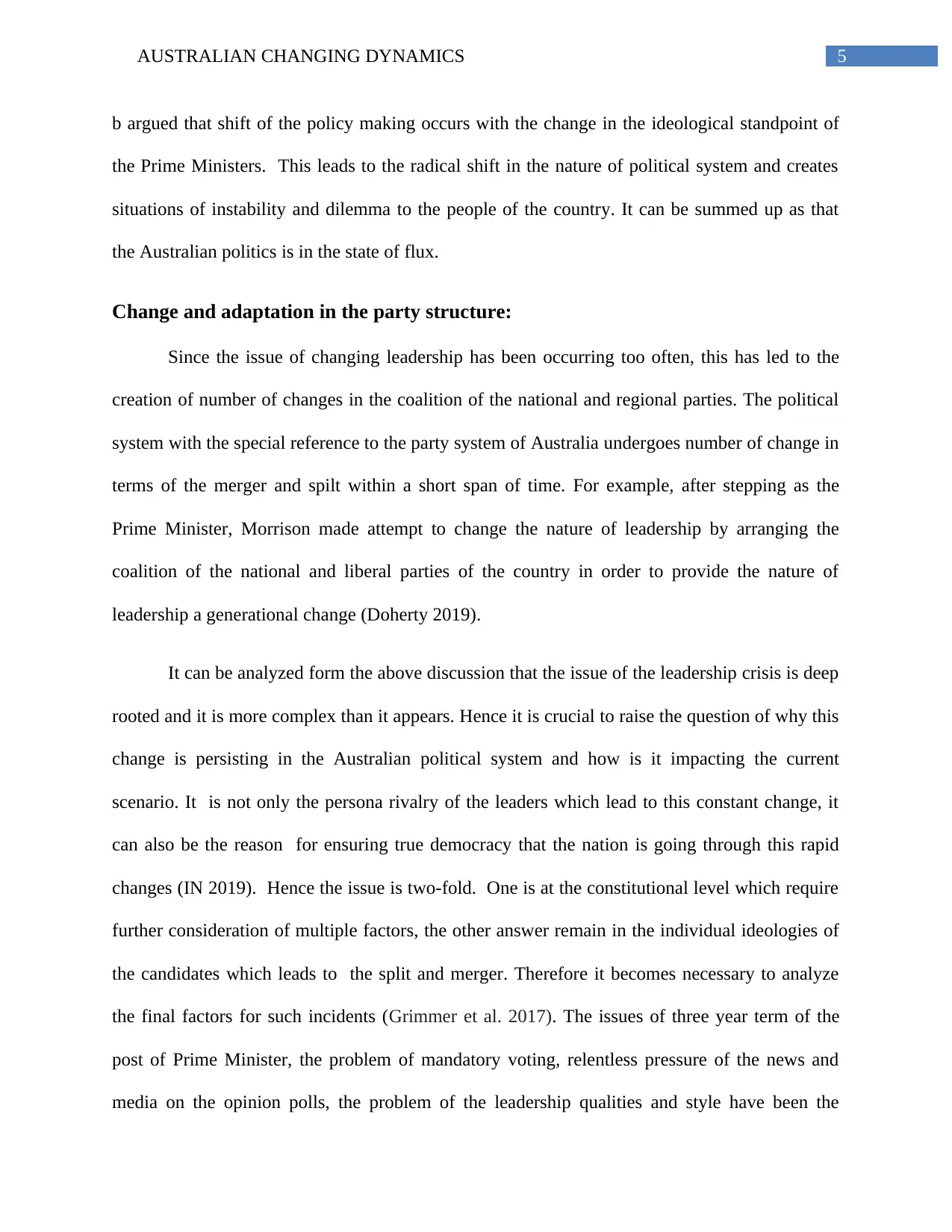
5AUSTRALIAN CHANGING DYNAMICS
b argued that shift of the policy making occurs with the change in the ideological standpoint of
the Prime Ministers. This leads to the radical shift in the nature of political system and creates
situations of instability and dilemma to the people of the country. It can be summed up as that
the Australian politics is in the state of flux.
Change and adaptation in the party structure:
Since the issue of changing leadership has been occurring too often, this has led to the
creation of number of changes in the coalition of the national and regional parties. The political
system with the special reference to the party system of Australia undergoes number of change in
terms of the merger and spilt within a short span of time. For example, after stepping as the
Prime Minister, Morrison made attempt to change the nature of leadership by arranging the
coalition of the national and liberal parties of the country in order to provide the nature of
leadership a generational change (Doherty 2019).
It can be analyzed form the above discussion that the issue of the leadership crisis is deep
rooted and it is more complex than it appears. Hence it is crucial to raise the question of why this
change is persisting in the Australian political system and how is it impacting the current
scenario. It is not only the persona rivalry of the leaders which lead to this constant change, it
can also be the reason for ensuring true democracy that the nation is going through this rapid
changes (IN 2019). Hence the issue is two-fold. One is at the constitutional level which require
further consideration of multiple factors, the other answer remain in the individual ideologies of
the candidates which leads to the split and merger. Therefore it becomes necessary to analyze
the final factors for such incidents (Grimmer et al. 2017). The issues of three year term of the
post of Prime Minister, the problem of mandatory voting, relentless pressure of the news and
media on the opinion polls, the problem of the leadership qualities and style have been the
b argued that shift of the policy making occurs with the change in the ideological standpoint of
the Prime Ministers. This leads to the radical shift in the nature of political system and creates
situations of instability and dilemma to the people of the country. It can be summed up as that
the Australian politics is in the state of flux.
Change and adaptation in the party structure:
Since the issue of changing leadership has been occurring too often, this has led to the
creation of number of changes in the coalition of the national and regional parties. The political
system with the special reference to the party system of Australia undergoes number of change in
terms of the merger and spilt within a short span of time. For example, after stepping as the
Prime Minister, Morrison made attempt to change the nature of leadership by arranging the
coalition of the national and liberal parties of the country in order to provide the nature of
leadership a generational change (Doherty 2019).
It can be analyzed form the above discussion that the issue of the leadership crisis is deep
rooted and it is more complex than it appears. Hence it is crucial to raise the question of why this
change is persisting in the Australian political system and how is it impacting the current
scenario. It is not only the persona rivalry of the leaders which lead to this constant change, it
can also be the reason for ensuring true democracy that the nation is going through this rapid
changes (IN 2019). Hence the issue is two-fold. One is at the constitutional level which require
further consideration of multiple factors, the other answer remain in the individual ideologies of
the candidates which leads to the split and merger. Therefore it becomes necessary to analyze
the final factors for such incidents (Grimmer et al. 2017). The issues of three year term of the
post of Prime Minister, the problem of mandatory voting, relentless pressure of the news and
media on the opinion polls, the problem of the leadership qualities and style have been the
⊘ This is a preview!⊘
Do you want full access?
Subscribe today to unlock all pages.

Trusted by 1+ million students worldwide
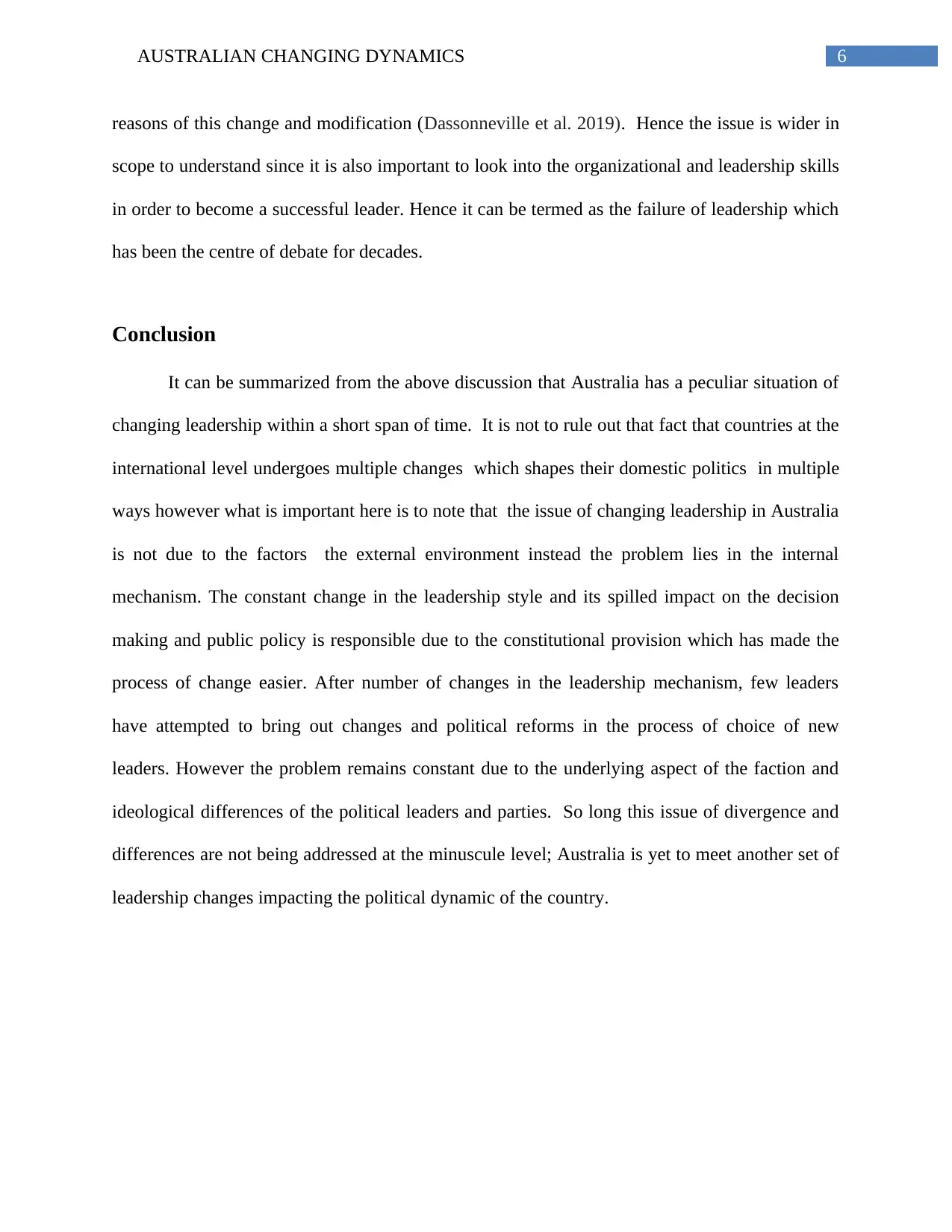
6AUSTRALIAN CHANGING DYNAMICS
reasons of this change and modification (Dassonneville et al. 2019). Hence the issue is wider in
scope to understand since it is also important to look into the organizational and leadership skills
in order to become a successful leader. Hence it can be termed as the failure of leadership which
has been the centre of debate for decades.
Conclusion
It can be summarized from the above discussion that Australia has a peculiar situation of
changing leadership within a short span of time. It is not to rule out that fact that countries at the
international level undergoes multiple changes which shapes their domestic politics in multiple
ways however what is important here is to note that the issue of changing leadership in Australia
is not due to the factors the external environment instead the problem lies in the internal
mechanism. The constant change in the leadership style and its spilled impact on the decision
making and public policy is responsible due to the constitutional provision which has made the
process of change easier. After number of changes in the leadership mechanism, few leaders
have attempted to bring out changes and political reforms in the process of choice of new
leaders. However the problem remains constant due to the underlying aspect of the faction and
ideological differences of the political leaders and parties. So long this issue of divergence and
differences are not being addressed at the minuscule level; Australia is yet to meet another set of
leadership changes impacting the political dynamic of the country.
reasons of this change and modification (Dassonneville et al. 2019). Hence the issue is wider in
scope to understand since it is also important to look into the organizational and leadership skills
in order to become a successful leader. Hence it can be termed as the failure of leadership which
has been the centre of debate for decades.
Conclusion
It can be summarized from the above discussion that Australia has a peculiar situation of
changing leadership within a short span of time. It is not to rule out that fact that countries at the
international level undergoes multiple changes which shapes their domestic politics in multiple
ways however what is important here is to note that the issue of changing leadership in Australia
is not due to the factors the external environment instead the problem lies in the internal
mechanism. The constant change in the leadership style and its spilled impact on the decision
making and public policy is responsible due to the constitutional provision which has made the
process of change easier. After number of changes in the leadership mechanism, few leaders
have attempted to bring out changes and political reforms in the process of choice of new
leaders. However the problem remains constant due to the underlying aspect of the faction and
ideological differences of the political leaders and parties. So long this issue of divergence and
differences are not being addressed at the minuscule level; Australia is yet to meet another set of
leadership changes impacting the political dynamic of the country.
Paraphrase This Document
Need a fresh take? Get an instant paraphrase of this document with our AI Paraphraser
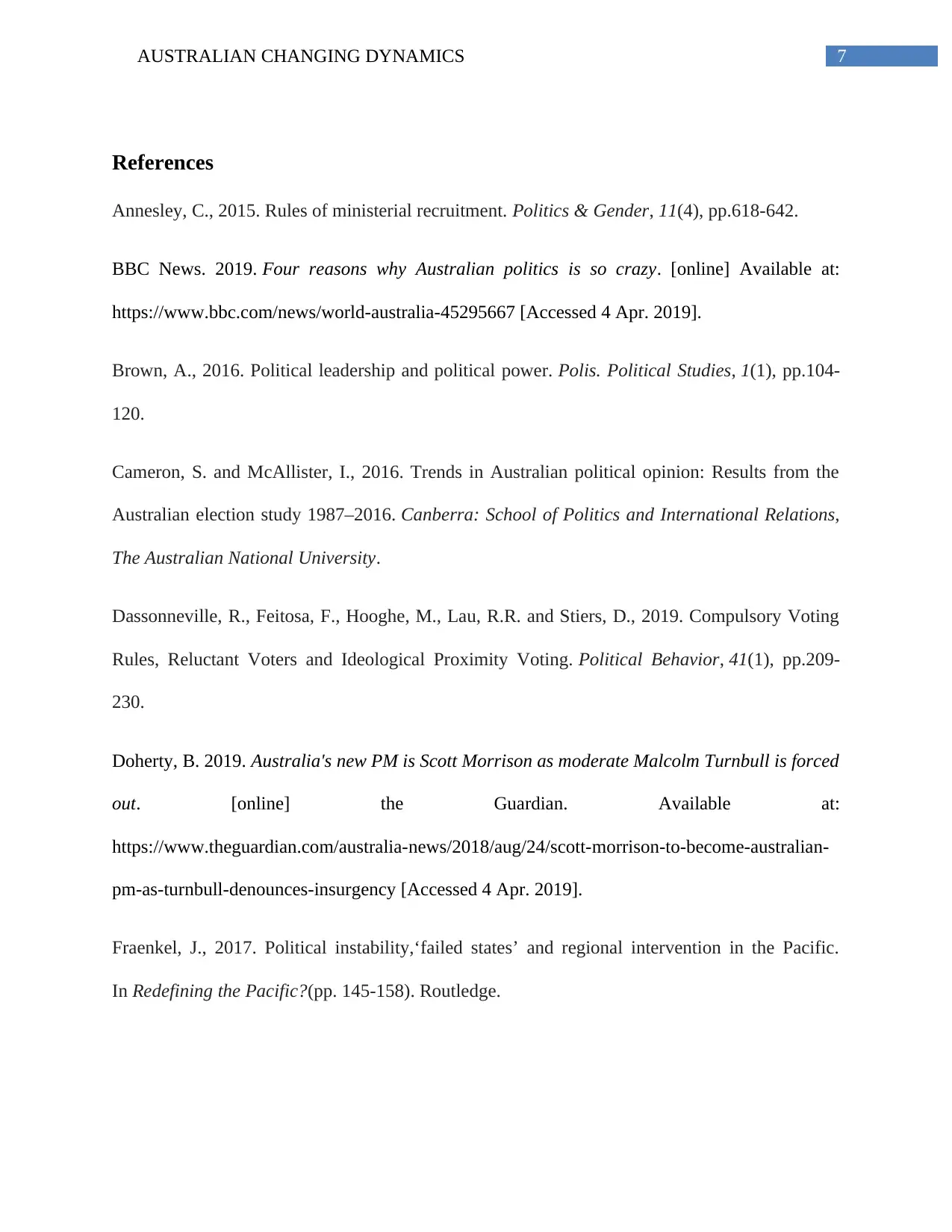
7AUSTRALIAN CHANGING DYNAMICS
References
Annesley, C., 2015. Rules of ministerial recruitment. Politics & Gender, 11(4), pp.618-642.
BBC News. 2019. Four reasons why Australian politics is so crazy. [online] Available at:
https://www.bbc.com/news/world-australia-45295667 [Accessed 4 Apr. 2019].
Brown, A., 2016. Political leadership and political power. Polis. Political Studies, 1(1), pp.104-
120.
Cameron, S. and McAllister, I., 2016. Trends in Australian political opinion: Results from the
Australian election study 1987–2016. Canberra: School of Politics and International Relations,
The Australian National University.
Dassonneville, R., Feitosa, F., Hooghe, M., Lau, R.R. and Stiers, D., 2019. Compulsory Voting
Rules, Reluctant Voters and Ideological Proximity Voting. Political Behavior, 41(1), pp.209-
230.
Doherty, B. 2019. Australia's new PM is Scott Morrison as moderate Malcolm Turnbull is forced
out. [online] the Guardian. Available at:
https://www.theguardian.com/australia-news/2018/aug/24/scott-morrison-to-become-australian-
pm-as-turnbull-denounces-insurgency [Accessed 4 Apr. 2019].
Fraenkel, J., 2017. Political instability,‘failed states’ and regional intervention in the Pacific.
In Redefining the Pacific?(pp. 145-158). Routledge.
References
Annesley, C., 2015. Rules of ministerial recruitment. Politics & Gender, 11(4), pp.618-642.
BBC News. 2019. Four reasons why Australian politics is so crazy. [online] Available at:
https://www.bbc.com/news/world-australia-45295667 [Accessed 4 Apr. 2019].
Brown, A., 2016. Political leadership and political power. Polis. Political Studies, 1(1), pp.104-
120.
Cameron, S. and McAllister, I., 2016. Trends in Australian political opinion: Results from the
Australian election study 1987–2016. Canberra: School of Politics and International Relations,
The Australian National University.
Dassonneville, R., Feitosa, F., Hooghe, M., Lau, R.R. and Stiers, D., 2019. Compulsory Voting
Rules, Reluctant Voters and Ideological Proximity Voting. Political Behavior, 41(1), pp.209-
230.
Doherty, B. 2019. Australia's new PM is Scott Morrison as moderate Malcolm Turnbull is forced
out. [online] the Guardian. Available at:
https://www.theguardian.com/australia-news/2018/aug/24/scott-morrison-to-become-australian-
pm-as-turnbull-denounces-insurgency [Accessed 4 Apr. 2019].
Fraenkel, J., 2017. Political instability,‘failed states’ and regional intervention in the Pacific.
In Redefining the Pacific?(pp. 145-158). Routledge.
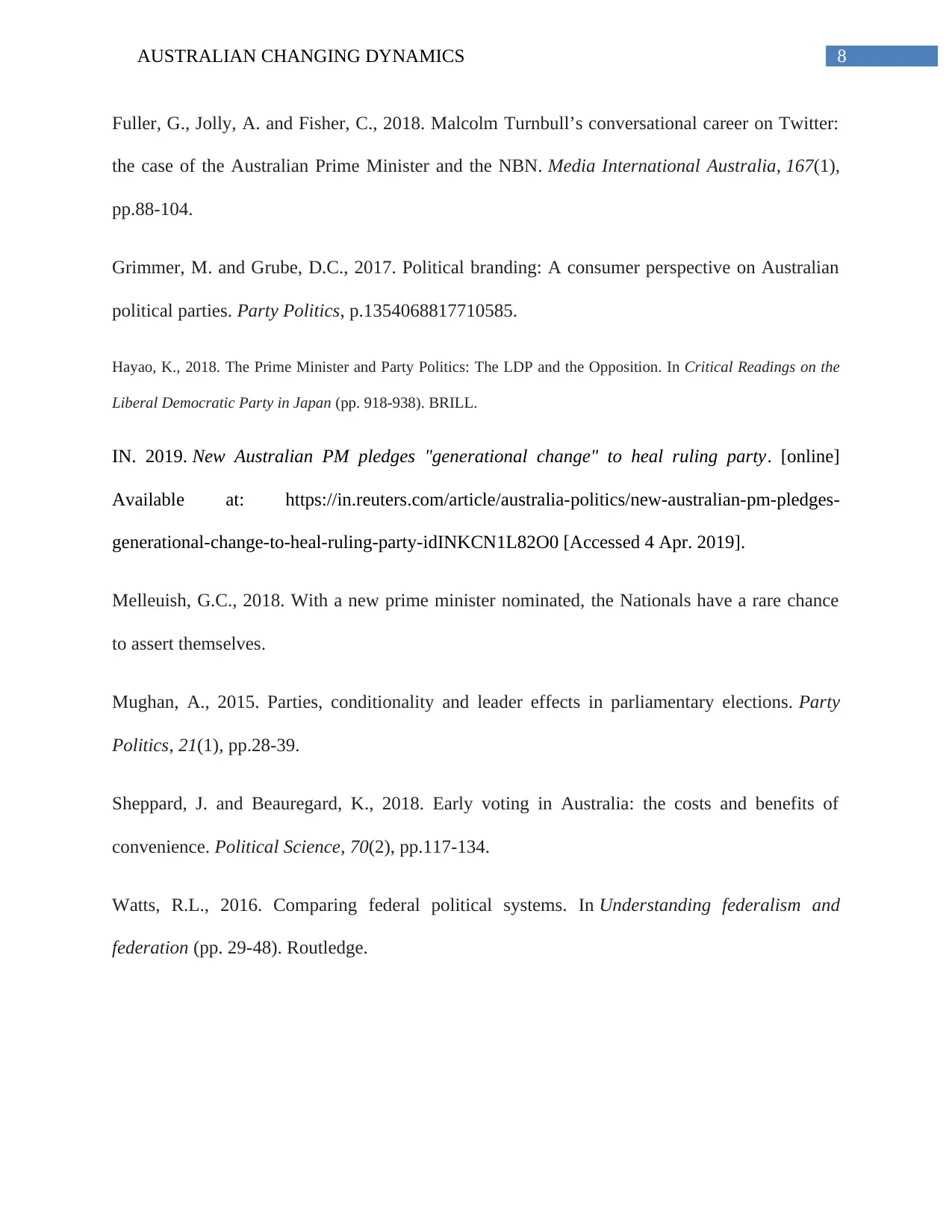
8AUSTRALIAN CHANGING DYNAMICS
Fuller, G., Jolly, A. and Fisher, C., 2018. Malcolm Turnbull’s conversational career on Twitter:
the case of the Australian Prime Minister and the NBN. Media International Australia, 167(1),
pp.88-104.
Grimmer, M. and Grube, D.C., 2017. Political branding: A consumer perspective on Australian
political parties. Party Politics, p.1354068817710585.
Hayao, K., 2018. The Prime Minister and Party Politics: The LDP and the Opposition. In Critical Readings on the
Liberal Democratic Party in Japan (pp. 918-938). BRILL.
IN. 2019. New Australian PM pledges "generational change" to heal ruling party. [online]
Available at: https://in.reuters.com/article/australia-politics/new-australian-pm-pledges-
generational-change-to-heal-ruling-party-idINKCN1L82O0 [Accessed 4 Apr. 2019].
Melleuish, G.C., 2018. With a new prime minister nominated, the Nationals have a rare chance
to assert themselves.
Mughan, A., 2015. Parties, conditionality and leader effects in parliamentary elections. Party
Politics, 21(1), pp.28-39.
Sheppard, J. and Beauregard, K., 2018. Early voting in Australia: the costs and benefits of
convenience. Political Science, 70(2), pp.117-134.
Watts, R.L., 2016. Comparing federal political systems. In Understanding federalism and
federation (pp. 29-48). Routledge.
Fuller, G., Jolly, A. and Fisher, C., 2018. Malcolm Turnbull’s conversational career on Twitter:
the case of the Australian Prime Minister and the NBN. Media International Australia, 167(1),
pp.88-104.
Grimmer, M. and Grube, D.C., 2017. Political branding: A consumer perspective on Australian
political parties. Party Politics, p.1354068817710585.
Hayao, K., 2018. The Prime Minister and Party Politics: The LDP and the Opposition. In Critical Readings on the
Liberal Democratic Party in Japan (pp. 918-938). BRILL.
IN. 2019. New Australian PM pledges "generational change" to heal ruling party. [online]
Available at: https://in.reuters.com/article/australia-politics/new-australian-pm-pledges-
generational-change-to-heal-ruling-party-idINKCN1L82O0 [Accessed 4 Apr. 2019].
Melleuish, G.C., 2018. With a new prime minister nominated, the Nationals have a rare chance
to assert themselves.
Mughan, A., 2015. Parties, conditionality and leader effects in parliamentary elections. Party
Politics, 21(1), pp.28-39.
Sheppard, J. and Beauregard, K., 2018. Early voting in Australia: the costs and benefits of
convenience. Political Science, 70(2), pp.117-134.
Watts, R.L., 2016. Comparing federal political systems. In Understanding federalism and
federation (pp. 29-48). Routledge.
⊘ This is a preview!⊘
Do you want full access?
Subscribe today to unlock all pages.

Trusted by 1+ million students worldwide
1 out of 9
Related Documents
Your All-in-One AI-Powered Toolkit for Academic Success.
+13062052269
info@desklib.com
Available 24*7 on WhatsApp / Email
![[object Object]](/_next/static/media/star-bottom.7253800d.svg)
Unlock your academic potential
Copyright © 2020–2025 A2Z Services. All Rights Reserved. Developed and managed by ZUCOL.





